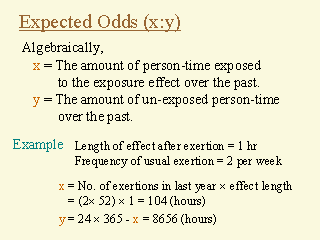 |
- If, over the past week, a subject exposed x hours to the effect of exertion, and the other y hours were not exposed to. The assumption that "the disease is a random event" means the disease can happen any time over the past week. In another words, any hour over the past week would have the same chance to have the disease fallen in that particular hour. Therefore, the odds that the disease occurred in the effect period after the exposure would be x:y.
- Thus, algebraically, in the expected odds (x:y), x is the amount of person-time exposed to the exposure effect and y is the unexposed person-time. To estimate the amount of "exposed" person-time, we will multiply the reported usual frequency of exposure, say exertion, by the length of exposure effect period; and the unexposed person-time is then calculated by subtracting the exposed person-time from the total person-time.
|
